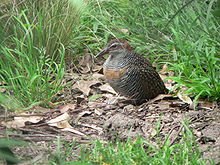- Cocos Buff-banded Rail
-
Cocos Buff-banded Rail 
Conservation status Scientific classification Kingdom: Animalia Phylum: Chordata Class: Aves Order: Gruiformes Family: Rallidae Genus: Gallirallus Species: G. philippensis Subspecies: G. p. andrewsi Trinomial name Gallirallus philippensis andrewsi
(Mathews, 1911)The Cocos Buff-banded Rail, Gallirallus philippensis andrewsi, is an endangered subspecies of the Buff-banded Rail endemic to the Cocos (Keeling) Islands, an Australian Offshore Territory in the central-eastern Indian Ocean.[2] The local Cocos Malay name of the bird is Ayam Hutan ("Chicken of the Forest").[3]
Contents
Distribution and habitat
This bird is now effectively limited to the 1.2 km² North Keeling Island. It is still occasionally reported from the 26 islands comprising the Southern Atoll of the Cocos (Keeling) Islands, where it was once common, but recent surveys have failed to find it. It is apparently extinct throughout the Southern Atoll apart from occasional visits by birds dispersing from North Keeling, which are unable to establish viable populations.[4]
On North Keeling the Rails occupy all the limited ground habitats on the island, including the shore of the lagoon and the understorey vegetation of Pisonia forest and Coconut palms.[5] Population size is estimated as 850-1000 birds, with a population density of 7-8 birds/ha.[4]
Behaviour
Diet
The Rails are omnivorous, foraging over the ground throughout the island and the intertidal fringe of the central lagoon for crustaceans, molluscs, insects, worms, seeds, fruits, eggs and carrion, as well as scavenging the refuse of the seabird breeding colonies.[2][5]
Conservation
The probable causes of extinction on the islands of the Southern Atoll are habitat clearance and predation by introduced mammals, including feral cats, Black Rats and humans, as well as competition with feral junglefowl.[2] Threats to the only remaining breeding population on North Keeling are the introduced Yellow Crazy Ant, the possibility of accidental introduction of terrestrial predators, and the impact of cyclones and tsunamis. North Keeling is entirely contained within the Pulu Keeling National Park, but the island is so small that reintroduction of the Rail to one or more of the southern islands, after habitat preparation, is envisaged as a precautionary measure.[4][5] The Cocos Buff-banded Rail is classified as Endangered under Australia's Environment Protection and Biodiversity Conservation Act 1999.[2]
As the only bird taxon endemic to the Territory, the Cocos Buff-banded Rail has featured frequently on postage stamps issued by the Australian Government for the Cocos (Keeling) Islands.[3]
References
- ^ Gallirallus philippensis andrewsi — Buff-banded Rail (Cocos (Keeling) Islands), Species Profile and Threats Database, Department of the Environment and Heritage, Australia.
- ^ a b c d Commonwealth of Australia. (2005). National Recovery Plan for the Buff-banded Rail (Cocos (Keeling) Islands) Gallirallus philippensis andrewsi. Department of the Environment and Heritage, Canberra. ISBN 0-642-55226-6
- ^ a b Bird stamps from Cocos Islands
- ^ a b c Reid, Julian R.W.; & Hill, Brydie M (2005). Recent Surveys of the Cocos Buff-banded Rail (Gallirallus philippensis andrewsi). Report to the Australian Government Department of the Environment and Heritage. Centre for Resource and Environmental Studies, Australian National University: Canberra. ISBN 0-642-55193-6
- ^ a b c Garnett, Stephen T.; & Crowley, Gabriel M. (2000). The Action Plan for Australian Birds 2000. Environment Australia: Canberra. ISBN 0-642-54683-5
Categories:- EPBC Act endangered biota
- Gallirallus
- Birds of Australia
- Cocos (Keeling) Islands
- Endangered fauna of Australia
Wikimedia Foundation. 2010.

